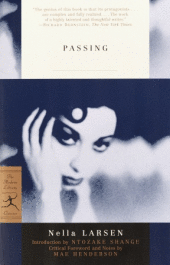Written: 1929
Read: 2008
“Passing” (1929) is a novel about passing for white. It was written by Nella Larsen in the days of the Harlem Renaissance. It tells the story of Clare Kendry, a light-skinned black woman who passes for white and marries a white man who hates blacks. It is the tale of a tragic mulatto, of someone who tries to escape her race and comes to a bad end.
Because Nella Larsen herself, the author, could pass for white and because she lived in the Harlem Renaissance, the book gives you an insider’s view of both. That alone makes it worth reading.
Black high society in Harlem in the 1920s seems surprisingly English: a thing of drawing rooms, tea parties and beautiful dresses. The book has that general cast to it, even the spelling! (Ntozake Shange calls her writing “exquisite”. I did not find it so, though it did have its moments.)
It is also a book about blackness and what it is, about the nature of race in America – which is probably why I have been writing so much about those things lately.
What makes you black? Is it in your blood – that one drop, as they say. Or is it a matter of your background and upbringing? Maybe it is a little of both – or something completely different.
Clare Kendry looks white, but she is dark like a Gypsy or a Jew. You would never think she was black unless you saw her with other black people – even if she does have “Negro eyes”.
Clare thinks that if she can live as a white woman she will be happier. She will have more money and life will be easier. People will not look down on her. She can go wherever she wants, eat at the nicest places and so on.
Her friend Irene Redfield could also pass for white, but she chose to marry a black doctor and live as a black woman in Harlem. There is something inside her that does not let her turn her back on her race.
She thinks Clare is playing a dangerous game: if she is ever found out she will lose everything: her husband, her daughter, her wealth, maybe even her life. Clare knows it is dangerous but she likes to live on the edge.
Whiteness does not buy happiness, as Clare finds out. Instead it makes her unhappy. She always feels out of place, she does not feel like she belongs, she does not feel free. She wants to be with black people, if only to hear them laugh again. And with blacks she can be free in a way she never can with whites.
So even though Clare acts white and talks white and even looks white and lives white, something deep inside her is still black. And that in the end is what counts.
– Abagond, 2008.
See also:

